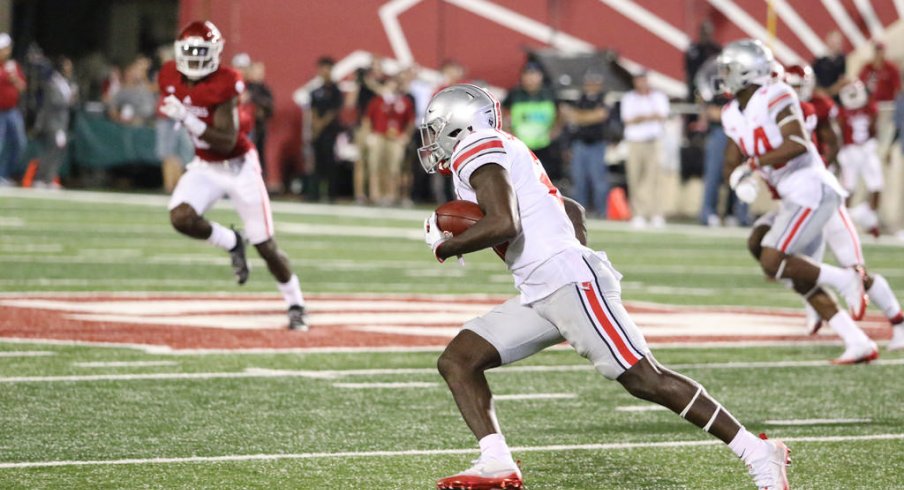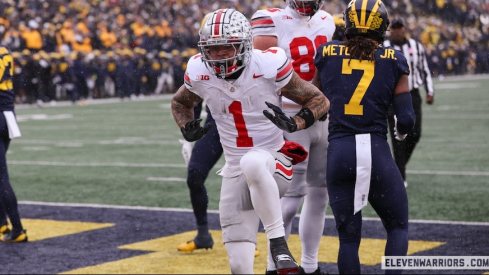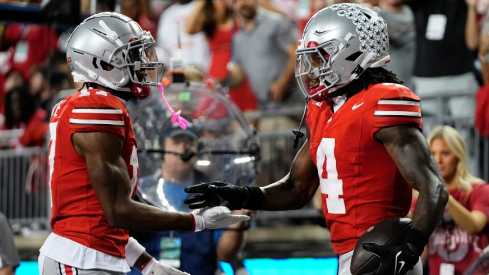It was the coaching...or the receivers...or the protection...or the QB.
Every interested party had a theory for why the Ohio State passing game struggled in 2016. But no matter the root cause last fall, the expectation both inside and out of the Woody Hayes Athletic Center was that those issues would be corrected in time for the 2017 opener in Bloomington, Indiana.
With two new masterminds, coordinator Kevin Wilson and QB coach Ryan Day, in the booth upstairs, a host of talented but untested receivers ready to make their mark, and a veteran signal-caller taking snaps, the Buckeye offense looked as dangerous as advertised on their opening drive against the Hoosiers on Thursday night. J.T. Barrett completed four of five attempts for 55 yards, spreading the ball around to a different receiver on each completion and making last fall seem like a distant memory.
As the first half progressed, however, the same old issues seemed to creep up. After a series of drops, overthrown passes, and check-downs to the backs, four consecutive OSU possessions ended in punts. As they headed to the locker room at halftime, Barrett's stat line was only 10-21 for 95 yards as his team had fallen behind the Hoosiers 14-13.
Even as the Buckeyes re-emerged for their first drive of the second half, the groans from Columbus reverberated throughout the internet as Parris Campbell dropped two big passes downfield - including a perfectly thrown ball into the end zone. But Campbell would, of course, find redemption on the next drive, turning a short crossing route into a 28-yard gain and setting up an eventual touchdown.
| Year | Comp % | Yds/att | Rating |
|---|---|---|---|
| 2017 | 57.1% | 8.7 | 158.3 |
| 2016 | 61.5% | 6.7 | 135.3 |
| 2015 | 62.5% | 6.7 | 141.5 |
| 2014 | 64.6% | 9.0 | 169.8 |
That completion to Campbell would ignite the OSU offense for the rest of the evening, with the short passing game taking center stage. Barrett would go 10-14, tallying 209 yards, and post a blistering 267.55 QB rating in the in the second half alone.
When examining what triggered the Dr. Jekyll and Mr. Hyde performance, the common play-calling seen on the first drive and then again in the second half clearly stands out.
Coming into this season, Barrett was known for his good decision-making and excellent short-to-medium accuracy. According to Pro Football Focus, Barrett's adjusted completion rate - which removes drops, throwaways, and balls thrown while the passer is hit - was the sixth-highest among returning QBs in the nation at 75.8% last fall. For comparison, that number tied expected top pick Sam Darnold's mark and was better than that of other top prospects like Josh Rosen, Mason Rudolph, and Lamar Jackson.
In fact, Barrett holds the highest mark of any returning QB in adjusted completion rate on passes thrown within 1-5 yards from the line of scrimmage at 93%. To take advantage of this trait, Wilson and Day installed a play that has long been a favorite of Day's former boss and mentor, Chip Kelly.
Kelly may be best known for his uptempo, zone-read driven offense that dominated at Oregon and eventually fell flat in the NFL, but back when he was calling plays at the University of New Hampshire - with Day taking snaps at QB - Kelly was assembling a Frankenstein-like offense featuring pieces and parts from every offensive system imaginable.
As Day told Philadelphia Magazine in 2015,
“At that time, we were changing offenses every week. We would go from Run ‘n Shoot to the Wing-T to the Veer. One week we threw it six times, the next week we threw it 65 times,” Day recalled. “Coach kind of had a laboratory there, and it was a lot of fun to be around.”
One of the schemes Kelly found at the time was a staple of Mike Martz's St Louis Rams playbook, known then as the Greatest Show on Turf. Martz had adapted the classic Air Raid 'Mesh' concept to fit his personnel, given he could call on one of the greatest pass-catching running backs of all time in Marshall Faulk.
In Martz's Mesh, there are still two short crossing routes in the middle of the field, but the QB's read starts with a wheel route to the back outside. If that's not open, he moves just inside to the first crossing route, then to a short hook route in the middle of the field that sits between the linebackers, before finally scanning back across the field to the other mesh crosser.
The Buckeyes called this play over and over against the Hoosiers, with many of the team's biggest plays all coming from it, including J.K. Dobbins' big third down reception on the opening drive, Campbell's initial catch and run, and Johnnie Dixon's 59-yard touchdown scamper.
However, 'Rams Mesh' wasn't the only crossing route concept that took advantage of the Buckeyes' existing skill set. Though Campbell, Dixon, and the rest of the young OSU receivers still seem to struggle with hauling in throws downfield, they're still blessed with exceptional speed and quickness.
Unlike years past in which the Buckeyes have tried to get similar players like Philly Brown, Braxton Miller, and Curtis Samuel the ball on option routes to the slot that ask the receiver to stand still before making a catch, crossing routes allow Barrett to make an easy throw that hits his receiver in stride, allowing these great athletes to make plays with their feet and not just their hands.
Campbell would rack up 136 receiving yards on the night, despite not catching a ball more than seven yards downfield. He was also the beneficiary of another Air Raid scheme Wilson and Day installed this spring, the Shallow Cross. While some versions call for the play-side slot receiver to run an 8-10 yard 'Dig' route, Wilson's runs a similar hook route to the Rams Mesh, creating a rub on the inside linebacker whom the QB is reading on the play and often freeing up the underneath crosser for an easy catch and run.
Concepts like these may not lead to the offense Urban Meyer often envisioned for his team, running the ball powerfully between the tackles before hitting deep shots over the top from play-action. However, they take advantage of the easy plays that are there for the personnel available.
While Ohio State's receiving corps may still be lacking in their ability to haul in the deep ball, they continue to be excellent blockers on the outside. Not only does this pay off in the running game, but also on these short crossing routes as Terry McLaurin showed while springing Campbell's 74-yard touchdown off the Shallow Cross with a huge block on the outside.
But while concepts like these will work against most, if not all, of the Buckeyes' Big Ten opponents, questions still remain about this offense's ability to perform against the best competition. Barrett, specifically, continued to look inconsistent throwing the deep ball.
J.T. Barrett lit up Indiana on the short throws, but his downfield passing was less than efficient. pic.twitter.com/9IWC4L0BIa
— CFB Film Room (@CFBFilmRoom) September 1, 2017
That passing chart will come as no surprise to scouts familiar with his 2016 results. Despite being the sixth-most accurate quarterback in the nation overall last fall, Pro Football Focus' rating system is far less kind to the fifth-year senior when examining passes thrown over 20 yards.
In 2016, Barrett's adjusted completion percentage on such throws was 37.9%, good enough for only 43rd among returning QBs this season. After only one game in 2017, that number sits at zero, though, with his longest completion through the air coming on a 15-yard crossing route to tight end Marcus Baugh on the opening drive.
While the passing game was certainly more efficient in the 2017 season opener than what we often saw in 2016, there is still plenty of work to be done. Wilson and Day will have to get creative about the way they hide these crossing concepts before the snap with different motions and formations, as every opponent on the schedule will make stopping them a priority.
However, the Oklahomas, Penn States, and Michigans of the world will not only be ready for these underneath routes but will have the athletes to run with Campbell and Dixon after the catch as well. For the Buckeye offense to truly take flight in 2017, a diverse assortment of pass concepts must emerge that can attack defenses between the hashes, outside the numbers, underneath the linebackers, and downfield behind the safeties.
Without that range of options through the air, Barrett and the Buckeyes won't reach their lofty goals.



